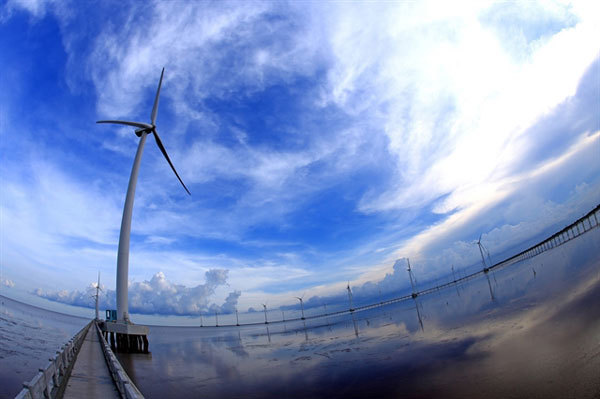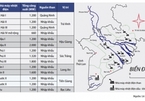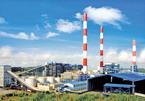 |
| Wind turbines in the southern province of Bac Lieu. NGOs are pusing for a reduction of coal and fossil fuel power, the development of renewable energy, and the efficient usage of energy. VNA/VNS Photo |
At the event, held on the occasion of the air quality awareness week, US Chargé d’Affaires to Vietnam Caryn McClelland said coal power affects not only the environment but also people’s livelihoods and social order around the plants, noting that the surrounding areas of coal-fired power plants are impacted the most.
Statistics from the Green Innovation and Development Centre (GreenID) show that emissions in the life cycle of a 1,200MW coal-fired power plant include about 17 tonnes of lead, 1.66 tonnes of mercury, 117,818 tonnes of NO2, more than 139,600 tonnes of SO2, and nearly 26,200 tonnes of dust. The most dangerous is particulate matter that is less than 2.5 micrometres in diameter (PM2.5), equivalent to only one-thirtieth of a human hair.
GreenID director Nguy Thi Khanh said a survey of residents near the Duyen Hai, Vung Ang and Hai Phong thermal power plants shows that coal power generation has seriously affected their health.
Giving further details about air pollution’s influence on public health, Nguyen Thi Trang Nhung, a researcher at the Hanoi’s University of Public Health, said the research team focused on children’s health and collected data from the National Cancer Hospital and air monitoring stations from 2008 to 2014.
Results showed that most pollutants caused respiratory diseases in children; the possibility of disease contraction in summer is higher than in winter; the older children are, the greater they are affected by air pollution; and boys are more vulnerable to air pollution than girls.
For people aged 16 and above, the team studied hospitalised cardiovascular cases in Hanoi and the northern provinces of Quang Ninh and Phu Tho, finding that PM1 and PM2.5 are linked with cardiovascular and chronic obstructive pulmonary diseases and lead to asthma and strokes in people over 64 years old.
However, the studies were limited since they did not assess long-term impacts and the number of air monitoring stations remained low, Nhung noted.
At the discussion, Khanh recommended that relevant ministries and sectors issue policies on air environment protection such as aligning domestic emission standards with international norms, prioritising renewable energy development, and promoting the use of public transport and electric vehicles.
Representatives from other non-governmental organisations urged the reduction of coal and fossil fuel power, the development of renewable energy, and the efficient use of energy.
They also called on Vietnam to be prudent in its electricity sector development strategy until 2030, or the country could face consequences in terms of the environment and human health. — VNS
|
Capacity of coal-fired power plants to drop in 2025
|

Major causes of air pollution in HCMC, Hanoi determined
Gas emissions from vehicles, exhaust from factories and industries and air pollutants from construction sites were identified as the three main causes of the deteriorating air quality in HCMC and Hanoi at an urgent meeting on air pollution yesterday.

Coal-fired thermopower may kill aquaculture in Mekong Delta
Aquaculture is one of the economic pillars and important livelihoods of the Mekong Delta. However, it is threatened by coal-fired thermopower plants.

Vietnam urged to stop investing in coal-fired thermal power
If Vietnam stops investments in new coal-fired thermopower projects, the total amount of coal it would consume could drop by 221 million tons by 2050.
 Participants at a recent conference in Hanoi called for smarter energy choices, given the impacts of coal power generation on air quality and air pollution’s influence on human health.
Participants at a recent conference in Hanoi called for smarter energy choices, given the impacts of coal power generation on air quality and air pollution’s influence on human health.